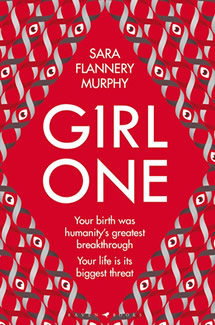Reviewed by Robert Goodman.
By Sarah Flannery Murphy, Bloomsbury.
 In her second book, Girl One, Sarah Flannery Murphy once again demonstrates the power of a great premise. Her debut, The Possessions, featured workers who could use a particular drug to contact and be inhabited by the spirits of the dead. She used this scenario to explore issues around addiction and grief but also, as an analogy, legalised prostitution. In Girl One, she once again uses a slight shift in reality to drive the drama but also, in this case, to ask explore a range of questions around identity, gender relations and scientific ethics.
In her second book, Girl One, Sarah Flannery Murphy once again demonstrates the power of a great premise. Her debut, The Possessions, featured workers who could use a particular drug to contact and be inhabited by the spirits of the dead. She used this scenario to explore issues around addiction and grief but also, as an analogy, legalised prostitution. In Girl One, she once again uses a slight shift in reality to drive the drama but also, in this case, to ask explore a range of questions around identity, gender relations and scientific ethics.
Josephine Morrow is ‘Girl One’, the first of nine miracle babies (all known popularly by their number) born in the early seventies through a process of parthenogenesis (conceived without the need for male DNA). After the birth of the ninth daughter and a fire at the compound on which they all lived which caused the death of the lead researcher Dr Bellanger, no one has been able to replicate the experiment. The book opens in the mid-1990s. Josephine, now a young adult, is picking up the research of her lost father figure but has to put that work on hold when her mother, from whom she has been estranged, disappears following another mysterious fire. Together with a journalist, Josephine goes on the road to follow her mother’s trail, leading her to her “sisters” and their mothers and along the way forcing her to re-evaluate her understanding of the past.
Murphy makes the most of her premise. Girl One starts off feeling like one type of book – a kind of road trip of discovery. And while it never quite loses that feel it slowly and logically (within the world of the book) morphs into something else entirely as the journey goes on and secrets starts to emerge. But the whole remains thematically consistent. Murphy uses her scenario and characters to dig deep into, among other things, the different ways men and women are treated and treat each other, to explore mythology around witches and superstitions related to powerful or intelligent women, to delve into obsession and the abuse of power.
Murphy does not labour any of these points. Aside from the “girls” and their story of their birth, the world of the 1990s is pretty much as readers who are old enough will remember it. This allows her to deliver a speculative thriller that also feels grounded. Josephine is a flawed but relatable protagonist who has a quest but is on her own personal journey to discover her own identity. These elements all come together to make Girl One another clever, thought provoking and engaging novel from Murphy.
This and over 700 more reviews can be found on Pile by The Bed.











